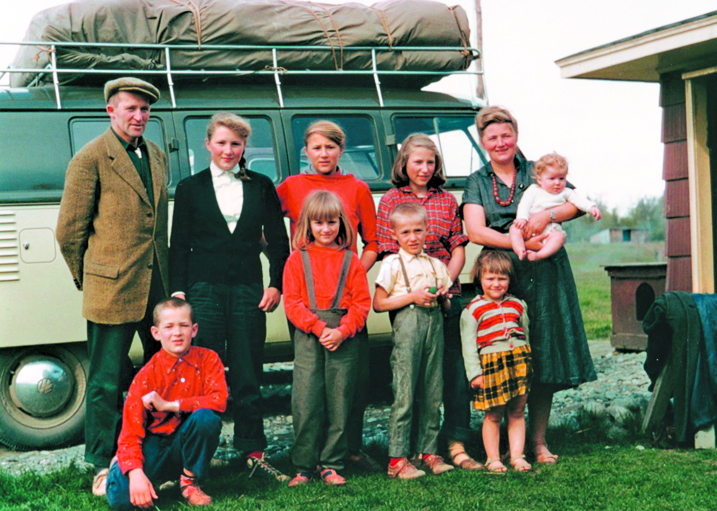The six sisters from Homer’s widely-known homesteading family, the Kilchers, will talk about their experience making a life as first generation homesteaders in Alaska at a discussion panel in Beatrice, Neb., on June 18 and 19. The panel is a featured part of the 100th anniversary homestead celebration at the Homestead National Monument of America.
The Kilcher sisters — Wurtilla Hepp, Fay Graham, Catkin Kilcher Burton, Stellavera Kilcher, Mossy Kilcher, and Sunrise Sjoeberg — are the only Alaskan homesteaders at the event, Homestead National Monument of America park ranger and volunteer manager Susan Cook said in an email. The two brothers, who make a total of eight Kilcher children, will not attend the event.
In addition to the first generation homesteaders, members of the second generation — Fay’s daughter Anna Smith, Otto’s son Eivin Kilcher and Atz’s son Shane Kilcher — will attend the event.
The event will not be broadcast online, though the park may tape the panel, Cook said.
The panel event will explore the way of life experienced by the Kilcher family, which shaped the lives and world view of the Kilcher children. Cook will also ask questions about what the land still means to the Kilchers. Speaking at the event will be a meaningful way to reconnect with their past.
“It brings home to me what a big, long full circle I’ve made and it’s a real gift to me just to be aware of who I am. It’s such a part of who I am and I’ve taken that for granted,” Sunrise said. “We didn’t take things for granted on the homestead. Even an orange was an amazing thing to have.”
The Kilchers grew up in a world different from modern Homer life, but has aspects that people are trying to recreate, Fay said. The Kilchers homesteaded in a time before everything was on-demand, but took time to craft everything they used. Despite the progress of the last several decades, many people now want to cultivate skills like growing their own food, canning produce and other things that the Kilchers did out of necessity.
“I think there’s a movement in going back to nature and getting your hands in the dirt,” Fay said. “I think there’s a real issue with technology today with the Internet and the smart phone where people are disconnected from their physical environment.”
Though the movement to become more self-sufficient is an alternative to going to the grocery store or relying on other modern conveniences, the Kilchers lived in a time where there were no other options. The family ground their own flour, hunted and raised animals, and grew food on the farm, making all their meals from scratch, especially in the beginning years, because there were not many other options, Atz said.
Yule came to Homer from Switzerland in 1936 to establish the homestead, and Ruth followed in 1941. The family returned to Switzerland on extended trips to visit family in 1947 and 1956, during which Atz and Catkin were born. Otherwise, they were on the homestead, taming and cultivating the land.
“Times changed so fast; I went from the horse and buggy era into a digital age and satellites,” said Mossy, who is the eldest of the first generation Kilcher siblings.
The children were homeschooled until their early teens, when they went to public school, through a correspondence course called the Calver Course, because the elementary school was too far for the younger kids to walk to, Mossy said. Electricity came to the homestead in 1952.
Despite their simple living, the children did not lack for cosmopolitan education. The household always had magazines and newspapers from outside Alaska. Their European
parents both spoke multiple languages and their musical mother taught the children to sing. When Yule did presentations in Europe about homesteading in Alaska, the children would sing like the Von Trapp children during the event. The siblings plan to sing a folk song in similar fashion at the panel discussion in Nebraska.
As times changed, Yule saw many of the other original homesteads in the Homer area divided between children and grandchildren, to the point that they were just small subdivisions of land, Catkin said. Not wanting his and his family’s life’s work to eventually disappear over the years, Yule had a conservation easement set up in the early 1990s and started the Kilcher Family Trust. This move ensured that the Kilcher’s 600-acre property will stay preserved for future generations to see and learn from. On it, the children have small home sites, which must maintain a rustic look. The land can be farmed, but it cannot be subdivided.
Preserving their homestead is important to the Kilcher children because it preserves the way they grew up that has all but disappeared. The Kilcher sisters agreed that living on the homestead affected and shaped their lives in distinct, unique ways. Overall, a sense of independence and strength is common among them.
Though much of history, and even the Discovery show “Alaska: the Last Frontier,” has a patriarchal focus, Ruth and her daughters did the same tasks as the men of the family and contributed just as much to the homestead, Catkin said. She hopes the panel will provide the opportunity to acknowledge and highlight the women’s input to their family’s history as well.
Anna Frost can be reached at anna.frost@homernews.com.


